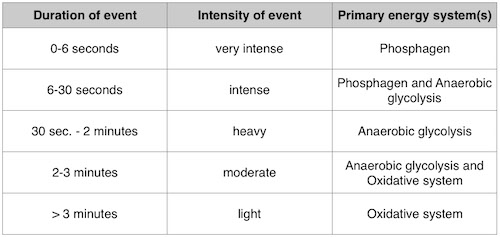Programming at all levels is influenced by the dominant energy system of any sport. Strength training predominantly targets the anaerobic energy system, although acute exercise variables such as repetitions, tempo and rest period can be manipulated to place stress on the lactic acid or aerobic energy systems.
The dominant energy system of any given work or sport activity can be determined by calculating the work/rest ratio of that activity. For instance tennis has a work/rest ratio of 10s/ 25s (8). As indicated in the table below, tennis is predominantly anaerobic, at least initially.
If the athlete is poorly conditioned, they may progressively move into the lactic acid and then aerobic energy systems due to lack of recovery time.
Because the anaerobic energy systems peak at approximately sixty seconds, it is important to keep total time under tension less than sixty seconds per set when attempting to develop maximal strength. If the exerciser is allowed to perform tempos of longer duration than sixty seconds per set, the aerobic system becomes progressively more dominant and the potential to maintain maximal tensile loading of the working tissues is lost.
In sports such as rowing, 400 and 800 meter running, short distance speed skating, rugby and boxing, the lactic acid system must be trained. This can be effectively accomplished by weight training with the right combination of acute exercise variables.
With sets of 30 repetitions or greater, it is suggested that an aerobic response exists in the working tissues.

